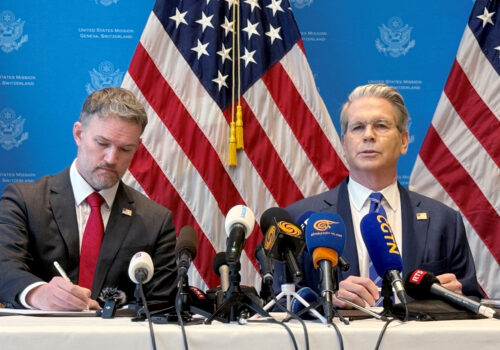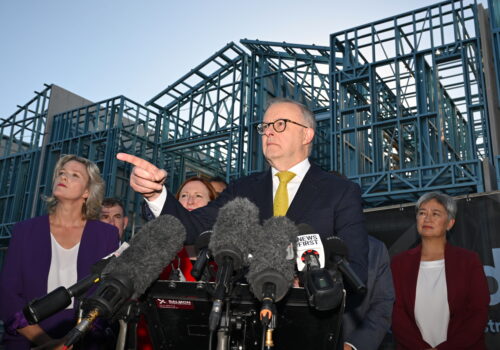The next 120 days of predictably volatile trade policy
Understandable relief associated with the de-escalating tariff war will soon fade as markets and corporations face a long, uncertain summer. US tariff truces with China and other global trading partners mark a turning point in the trade war, and countries begin to negotiate the terms of a major geoeconomic rebalancing. As Atlantic Council experts observed, the shift from multilateral trade negotiations at the World Trade Organization to bilateral tariff negotiations with the United States could impact the Bretton Woods trade policy framework and trigger considerable global economic upheaval.
Bilateral trade deals struck with Washington will redefine the balance of geoeconomic power and elicit powerful reactions domestically and abroad. In addition to negotiations with major trade partners (European Union, Mexico, Canada, China, Japan), at least twelve large economies reportedly have begun active trade talks with the United States. The first set of early agreements with the United Kingdom and India are incomplete; and new details could be announced at any point. These are not merely bilateral negotiations. Every public move and every new deal will change the landscape for negotiation among the other parties.
The timing for the tariff negotiations seems certain to trigger additional policy volatility throughout the summer as overlapping—but not aligned—deadlines approach in relation to both the trade talks and domestic fiscal policy negotiations. US deadlines for reaching reciprocal tariffs agreements with trading partners are set to expire one month before separate negotiations with China. All trade negotiations will occur amid parallel budget and debt ceiling negotiations in the United States, where a trio of additional domestic pressure points loom large this summer:
- Budget negotiations, including controversial spending cuts and initiatives to make permanent the tax cuts from President Trump’s first term in office
- Treasury borrowing needs and debt ceiling challenges
- Increasingly agitated opposition party roadblocks within Congress
Consequently, the next 120 days present a critical window for decision making that will generate ripple effects across the global economy. Choices made over this period will challenge corporate executives, financial institutions, and policymakers to chart solid trajectories amid an increasingly random news cycle that can trigger headline-driven market rollercoaster rides. Uncertainty regarding trade and tariffs could extend into the autumn and the new fiscal year if trade partners cannot agree. The prospect for revival of the draconian tariff hikes announced in early April 2025 increase the risks of potentially destabilizing outcomes.
The fiscal policy issues involve hard deadlines. US Treasury Secretary Scott Bessent’s letter to the speaker of the house on May 9 indicates that the next fiscal cliff (when taxpayer revenue must be supplemented by bond market sales in order to keep the government open) will likely materialize in August 2025. Secretary Bessent has requested that Congress increase the debt ceiling before departing for its traditional August recess. In other words, the deadline for resolving (or at least making progress on) the trade war truce with China now coincides with the debt ceiling “X date,” as well as the traditional summer recess for Congress.
These issues are not new. From President Barack Obama onward, the summer budget season in the United States has consistently included debt ceiling brinksmanship, hard budget negotiations, and plenty of breathless headlines. Summer 2025 will be still more intense. Budget negotiations play out amid both a strikingly poisonous political climate and major tariff negotiations, the outcomes of which will materially impact economic growth rates globally.
None of these inflection points align neatly with the quarterly reporting process that drives markets and corporate disclosures. Incomplete information within markets and corporates regarding daily policy decisions increases the risk of poor strategic decisions. Corporate executives understandably choose inaction pending final decisions. Inertia generates downstream slowdowns in economic activity, ratcheting up pressure on governments globally to deliver clarity. In such an environment, the risk of overreaction to a headline and a news story is high.
Those outside the policy process can, at least, anticipate new bouts of volatility and opportunity. Between June and September 2025, a number of scheduled events provide policymakers with potential offramps and opportunities to make deals, in addition to the steady stream of negotiating teams meeting with US government officials in Washington. These include:
- May 28-31, Department of Commerce rules due on the application of Section 232 tariffs regarding non-US content in auto parts
- June 3, South Korean election
- June 15-17, Group of Seven (G7) Summit in Canada
- June 19, Eurogroup Summit
- June 25-27, Penultimate Group of Twenty (G20) sherpa meeting
- June 27, EU Council Summit
- July 6-7, BRICS Summit in Brazil
- July 9, expiration of the current reciprocal tariff war ceasefire
- Mid-July, targeted date for debt ceiling extension by Congress
- July 29-31, G20 Trade and Investment Working Group meeting
- August 4, tentative Congress summer recess begins
- August 12, expiration of the reciprocal trade war with China ceasefire
- Mid-August, the latest estimate for the X date and the budget ceiling (the next fiscal cliff)
- August 21-23, Jackson Hole monetary policy conference
- September 30, end of the US fiscal year
- October 12, Department of Commerce Section 232 report due regarding critical minerals
- October 17, IMF and World Bank Annual Meetings (often with side meetings for the G20, the Financial Stability Board, the G7, and the BRICS)
- November 2, Department of Commerce Section 232 report due regarding timber and lumber
- 2026, USMCA partners must decide whether to extend or terminate the regional trade agreement
Several other events are expected, but at uncertain times. There might be changes to the United States-Mexico-Canada Agreement tariff structure, extensions to existing deadlines regarding tariff negotiations with the United States (particularly: July 9 and August 12), or a deterioration of truce terms. For example, the United States could revive at any time its doubling (to $200) of fees for de minimis packages shipped to the United States from China using the postal services.
News reports indicate that bilateral negotiations are underway between the United States and at least twelve significant global economies (in addition to ongoing negotiations with China, Canada, the European Union, the UK, and Mexico): Israel, Japan, Vietnam, Cambodia, Thailand, India, South Korea, Australia, Argentina, Switzerland, Malaysia, and Indonesia.
June and July will be a rolling feast of headlines and leaks. Each decision and headline will contribute to geoeconomic realignment, impact global growth rates, and shape the structure of cross-border economic engagement.
The current pause in the tariff war may be welcome, but the more intense negotiations still lie in the future. Never has it been more important to pay particular attention to every move of the policy cycle.
Barbara Matthews is a nonresident senior fellow at the Atlantic Council’s Geoeconomics Center. She is also founder and CEO of BCMstrategy, Inc., a company that generates AI training data and signals regarding public policy.

At the intersection of economics, finance, and foreign policy, the GeoEconomics Center is a translation hub with the goal of helping shape a better global economic future.
Further reading
Mon, May 12, 2025
Experts react: The US and China just agreed to dramatically reduce tariffs on each other, for now. What’s next?
Experts react By
Our experts explain what the ninety-day reduction in US-China tariffs means for Washington, Beijing, and the global trading system.
Mon, May 5, 2025
How Trump’s tariffs could reshape Australia’s strategic outlook
New Atlanticist By John T. Watts
If US policies continue in the spirit of “running up the score” on allies, then Australia may look to expand its military relationships with other countries.
Wed, Apr 30, 2025
Experts react: At last, the US and Ukraine signed a minerals deal. Here’s what to expect next.
New Atlanticist By
After months of wrangling, Washington and Kyiv quietly finalized a much-anticipated agreement on April 30. Atlantic Council experts dig into the details.
Image: The White House is the official residence and workplace of the president of the United States.



